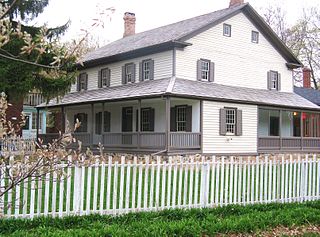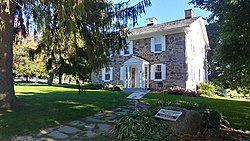
Waterloo is a city in the Canadian province of Ontario. It is one of three cities in the Regional Municipality of Waterloo. Waterloo is situated about 94 km (58 mi) west-southwest of Toronto, but it is not considered to be part of the Greater Toronto Area (GTA). Due to the close proximity of the city of Kitchener to Waterloo, the two together are often referred to as "Kitchener–Waterloo", "K-W", or "The Twin Cities".

Kitchener is a city in the Canadian province of Ontario, about 100 km (62 mi) west of Toronto. It is one of three cities that make up the Regional Municipality of Waterloo and is the regional seat. Kitchener was known as Berlin until a 1916 referendum changed its name. The city covers an area of 136.86 km2, and had a population of 256,885 at the time of the 2021 Canadian census.

The Pennsylvania Dutch, also referred to as Pennsylvania Germans, are an ethnic group in Pennsylvania and other regions of the United States, predominantly in the Mid-Atlantic region of the nation. They largely originate from the Palatinate region of Germany, and settled in Pennsylvania during the 17th, 18th, and 19th centuries. While most were from the Palatinate region of Germany, a lesser number were from other German-speaking areas of Germany and Europe, including Baden-Württemberg, Hesse, Saxony, and Rhineland in Germany, Switzerland, and the Alsace–Lorraine region of France.

The Regional Municipality of Waterloo is a metropolitan area of Southern Ontario, Canada. It contains the cities of Cambridge, Kitchener and Waterloo, and the townships of North Dumfries, Wellesley, Wilmot and Woolwich. Kitchener, the largest city, is the seat of government.

Elmira is the largest community in the township of Woolwich, Ontario, Canada. It is 15 kilometres (9 mi) north of the city of Waterloo near the Regional Municipality of Waterloo's northern border with Wellington County. The community was listed in the 2016 Canadian census as having a population of 10,161.

Conrad Grebel was a co-founder of the Swiss Brethren movement.

The Township of Woolwich is a rural township in Southwestern Ontario, Canada, considered as a municipality. The Township is located in the northeast part of Waterloo Region and is made up of 10 small communities, with Elmira, Ontario the largest and St. Jacobs, Ontario the second largest. The population at the time of the 2021 Census was 26,999, up from the 2016 population of 25,006. Waterloo Region is still home to the largest population of Old Order Mennonites in Canada, particularly in the areas around St Jacobs and Elmira. They are often seen on the local roads using their traditional horse and buggy transportation; many also use horses to pull the implements in their farm fields.

Waterloo County was a county in Canada West in the United Province of Canada from 1853 until 1867, then in the Canadian province of Ontario from 1867 until 1973. It was the direct predecessor of the Regional Municipality of Waterloo.

West Montrose is an unincorporated rural community in Woolwich Township in the Regional Municipality of Waterloo, Ontario, Canada. As of the 2016 census, the population of the community was 257.

The Grand River, formerly known as the River Ouse, is a large river in Ontario, Canada. It lies along the western fringe of the Greater Golden Horseshoe region of Ontario which overlaps the eastern portion of southwestern Ontario, sometimes referred to as Midwestern Ontario, along the length of this river. From its source near Wareham, Ontario, it flows south through Grand Valley, Fergus, Elora, Waterloo, Kitchener, Cambridge, Paris, Brantford, Ohsweken, Six Nations of the Grand River, Caledonia, and Cayuga before emptying into the north shore of Lake Erie south of Dunnville at Port Maitland. One of the scenic and spectacular features of the river is the falls and Gorge at Elora.
Old Order Mennonites form a branch of the Mennonite tradition. Old Order are those Mennonite groups of Swiss German and south German heritage who practice a lifestyle without some elements of modern technology, still drive a horse and buggy rather than cars, wear very conservative and modest dress, and have retained the old forms of worship, baptism and communion.

Conrad Grebel University College is a university college affiliated with the University of Waterloo in Waterloo, Ontario, Canada. It is affiliated with the Mennonite Church Canada.

The Schneider Haus National Historic Site, formerly Joseph Schneider Haus, is a museum in Kitchener, Ontario, Canada. Situated on some of the earliest land to be settled by non-Indigenous peoples in what would become Waterloo County, the museum includes the oldest remaining dwelling in the area and was named a National Historic Site of Canada in 1999.

Conestogo is a community in the Canadian province of Ontario, located in the township of Woolwich in Waterloo Region. The population in 2016 was 1,270.

Floradale is an unincorporated rural community in Southwestern Ontario, Canada. It is part of the township of Woolwich in the Regional Municipality of Waterloo. The community is located 5 kilometres to the north of the town of Elmira, Ontario and 20 kilometres to the north of the city of Waterloo, Ontario. Canagagigue Creek, a tributary of the Grand River, flows through the village. The community is located in an area where there is an historically large settlement of Old Order Mennonites noted for their traditional customs, dress, and use of horse and buggies.
The Markham-Waterloo Mennonite Conference (MWMC) is a Canadian, progressive Old Order Mennonite church established in 1939 in Ontario, Canada. It has its roots in the Old Order Mennonite Conference in Markham, Ontario, and in what is now called the Regional Municipality of Waterloo. The Conference adheres to the 1632 Dordrecht Confession of Faith. The Markham-Waterloo Mennonite Conference is in fellowship with two similar car-driving Old Order Mennonite churches: the Weaverland Mennonite Conference and the Ohio-Indiana Mennonite Conference.

The Hess Homestead, in Lancaster County, Pennsylvania, is a historic Mennonite farmstead near the town of Lititz. The property is an ancestral home of the Hess family, who purchased the land from William Penn's sons in 1735.

Doon is a suburban community and former village which is now a part of the city of Kitchener, Ontario, Canada. Doon was settled around 1800 by German Mennonites from Pennsylvania, and after 1830 by Scottish immigrants. The area is located at the confluence of Schneider Creek and the Grand River. The post office was opened in 1845. A large flour mill, oatmeal mill, distillery and sawmill were built on the Doon River over the following years. The Perine brothers established extensive linen works and flax mills near the settlement. By 1870, there was a single church, Presbyterian, a variety of tradesmen and a population of 200.
The Ontario Mennonite Conference is a moderate Old Order Mennonite group in the Canadian province of Ontario, that was formed in 1889 as a reaction to modernizing trends among the Mennonites in Ontario. The members use horse and buggy for transportation. As of 2020, they also have a colony in the Canadian province of Prince Edward Island.


















